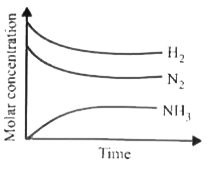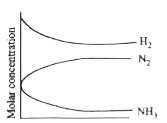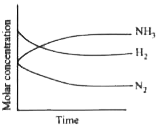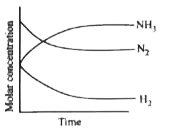N2 Molecular|Properties Of N2|Uses Of N2|NH3 Ammonia|Haber's Process|Properties|Uses Of NH3|Nitric Acid|Brown Ring Test|OMR
Step by step video solution for N2 Molecular|Properties Of N2|Uses Of N2|NH3 Ammonia|Haber's Process|Properties|Uses Of NH3|Nitric Acid|Brown Ring Test|OMR by Chemistry experts to help you in doubts & scoring excellent marks in Class 12 exams.
Updated on:21/07/2023Similar Questions
Knowledge Check
The catalyst used in Haber's process of production of NH3 now days is :
AFe+MoBIron oxide with K2O and Al2O3CIron oxide with Mo as promoterDAl2O3+FeCl3For the foramation of NH3 using Haber's process, identify the correct statement.
ABoth yield of the reaction as well as rate of ammonia formation will be more at high temperature.BYield of the reaction will be more in a large container at lower temperature as compared to small container at high temperature.CWhile yield of the reaction will increase with increase in temperature rate of formation will decrease with increase in temperature.DFor commercial production of ammonia, high pressure and high temperature are maintainedFor the synthesis of ammonia by the reaction,
N2+3H2⇔2NH3
in the Haber's process, the attainment of equilibriun is correctly predicted by the curveA B
B C
C D
D
Nitrogen-(N2)|Properties Of Nitrogen|Oxide Of Nitrogen|Ammonia With Its Properties|Oxcide Of Phosphorus With Its Properties
View SolutionAnomalous Properties Of Nitrogen|What Is Disproportionation Reaction?|Reactivity Towards Hydrogen|Dinitrogen|Ammonia|Nitric Acid|Brown Ring Test|Summary
View SolutionChemical Properties OF Family||Physical Properties OF Family||Dinitrogen N2|| Preparation||Properties and Uses|| Heating Effect OF Ammonium Salts
View SolutionAnswer the following :
Name the catalyst used in Haber’s Process for manufacture of NH3(g).
View SolutionIn a catalytic conversion of N2 to NH3 by Haber's process, the rate of reaction was expressed as change in the concentration of ammonia per time is 40×10−3molL−1s−1. If there are no side reaction, the rate of the reaction as expressed in terms of hydrogen is (in mol L−1s−1)
View Solution
